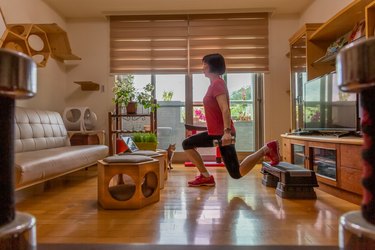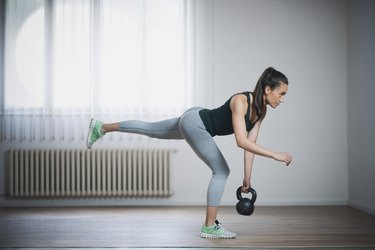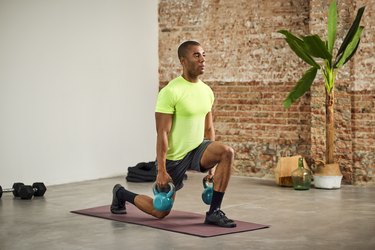
Are you feeling knee pain while running or hiking, especially when going downhill? If your downhills aren't as comfortable as your uphills, it's time to include knee-strengthening exercises in your routine to keep your legs strong and healthy.
Regular exercise has so many benefits, including reduced stress, boosted metabolism, stronger bones and a healthier heart. Adding hills to your workouts, with activities such as hiking, running or walking, is a great way to increase the intensity of your exercise and bump up the leg-strengthening benefits.
Video of the Day
A common complaint with downhill exercises, however, is knee pain. Luckily, you don't have to stick to flat terrain — knee-strengthening exercises, along with proper training, can get you back on the hills without pain, according to experts like ACE Physical Therapy & Sports Medicine Institute.
What Causes Downhill Knee Pain?
The added pressure on your knee when going downhill, especially when running, is responsible for the knee pain.
"When running downhill, the pressure that you're exerting on the legs is significantly greater than running on flats or on an incline," says exercise science professor and triathlete Todd Buckingham, PhD. "In fact, your legs can experience more than 1.5 times higher forces running downhill than running on level ground. This comes out to three to six times more force than your body weight."
That means for a 150-pound individual, their legs would experience 450 to 900 pounds of pressure with each step.
"Second, running downhill results in more braking forces and eccentric muscle contractions in order to control your descent," he says. "This also results in more muscle damage than running on flats or on an incline. This could cause you to be more sore in the day or two following your workout."
Strengthening the muscles that support your knee, like the quadriceps, hamstring, and glutes, will help absorb the shock and reduce the stress on your knee leading to less pain when running, hiking or walking, says the American Academy of Orthopaedic Surgeons.
An October 2019 study in the Annals of Translational Medicine found that knee-strengthening exercises, along with stretches, can also correct knee pain during running caused by abnormal movement of the patella (kneecap) caused by muscle imbalances.
In addition to muscle strengthening, a March 2017 study in PLOS One looked at knee pain with downhill walking and found that it was also important to add short-duration downhill training sessions for best results.
That means start with smaller hills (five minutes of downhill walking at a not-very-steep grade) and progress to longer distances and steeper hills as your pain tolerates.
The Best 10 Knee-Strengthening Exercises
Ready to get started? Board-certified sports physical therapist Leada Malek, DPT, and Buckingham share their top 10 best knee-strengthening exercises to improve strength and reduce pain.
"By strengthening the muscles of the legs and knees, you can better control your descents and have better stabilization of your leg muscles which can reduce the impact placed on your knees," Buckingham says.
Start with 3 sets of about 12 reps for each move a couple of times a week, and work your way up to 5 sets three days a week.
1. Squat
"Squats are great for loading the joints with a lot of weight to strengthen most of the muscles of the legs," says Buckingham.
- Stand with your feet slightly wider than hip-width, with your toes turned slightly out.
- Bend your knees and drive your hips back, as if you are sitting in a chair.
- Keep your heels and toes on the ground, with your shoulders back.
- Go down as far as you can, but no further than your thighs parallel to the ground.
- Return to the standing position.
- Repeat 2 sets of 12.
2. Single-Leg Squat
"Running is essentially jumping from one foot to the next and doing this over and over again," Buckingham says. This exercise will strengthen each leg individually to prepare them for the shock absorbency needed for running or hiking downhill.
- Stand with one leg held up slightly off the ground.
- You can place one hand on a chair as needed for balance.
- Squat down, bending your knee and pushing your hips back, as you keep one leg off the ground.
- Return to standing.
- Repeat 12 to 15 times.
- Repeat on the other leg.
- Do 2 sets.
3. Speed Skater
"This exercise is great for working the lateral muscles of the legs that help control the stability of the knee," Buckingham says. "The key is to control your balance on one foot before pushing off and jumping to the other foot."
- Stand with your feet slightly wider than shoulder-width apart with your knees slightly bent.
- Shift your weight to your right side and lift your left leg slightly.
- Push off with your right foot, jumping laterally, and land on your left foot.
- Your right leg should cross behind you, as your arms cross in front.
- Jump laterally to the other side, pushing off with your left foot and landing on your right foot.
- Continue this "speed skating" exercise for 15 to 30 seconds.
4. Bottle Touches
"This exercise is great for working the stabilization muscles of the ankle and lower leg that are often neglected in a runner's training plan," Buckingham says.
- Place three water bottles (or something similar) around your body: one to the left, one to the center and one to the right.
- Standing on one foot, bend down and reach with both hands together to touch the bottle to the left.
- Return to standing, bend down, and reach with both hands together to touch the bottle to the center.
- Return to standing, bend down, and reach with both hands together to touch the bottle to the right.
- Return to center.
- Continue 3 to 5 times.
5. Monster Walk
Placing a band around your thighs or even ankles and performing monster walks is a great way to work the muscles of the legs. "The key is to keep the band tight the entire time and not allow any slack in the band in order to keep tension on the muscles," Buckingham says.
- Place a resistance band around your thighs and above your knees.
- Stand with feet hip-width apart and with your knees slightly bent in a mini squat.
- Step forward, one foot at a time, keeping the tension on the band tight the entire time.
- Step backward, one foot at a time. Repeat 15 times in each direction.
Tip
Adding a side-to-side step to the start of monster walks is a good way to get maximum glute engagement. Read more about how to do lateral banded walks here.
6. Bulgarian Split Squat
"This exercise, also known as rear foot elevated split squats, is great for building unilateral strength and absorption strength," says Malek.
- Stand in a lunge position, with your back foot on a box or bench.
- Lunge or bend your front knee, moving down until your thigh is parallel to the ground.
- Keep your toes of your front leg behind your knee.
- Return to standing.
- Repeat 15 times for each leg.
- You can also hold weights or a barbell for added resistance.
7. Forward Lunge
"The forward lunge trains quad and glute strength, particularly to help with decelerating. This can be especially helpful for hills," Malek explains.
- Start with your legs shoulder-width apart.
- Step forward with your right leg in a lunge position.
- Bend both knees until your back knee is almost touching the floor.
- Your front thigh will be parallel to the ground.
- Return to standing.
- Repeat 15 times on each side.
8. Single-Leg Glute Bridge
"Glute and hamstring strength are key for hip extension," Malek says. "The single-leg bridge encourages unilateral strength."
- Lie on your back with your knees bent up and feet flat on the floor.
- Lift your right leg, straightening it and lifting until the right thigh is parallel with the left thigh.
- Pushing off your left foot, lift your hips up and off the ground.
- Hold for a few seconds, making sure to engage the glute at the top of the bridge, before returning to the starting position.
- Repeat 15 times on each side.
9. Single-Leg Romanian Deadlifts
"This works on single-leg balance, hip and knee stability, as well as eccentric hamstring strength," Malek says.
- Stand with your feet shoulder-width apart. Slightly raise one foot off of the ground.
- Hinge at the hips, and lower your torso or upper body down until it is parallel to the ground, keeping your back straight.
- Your opposite leg should be straight behind you.
- Hold this position for a couple of seconds.
- Contract your glutes and move yourself back to the starting position.
- Repeat 15 times on each leg.
- As you get stronger, you can progress to holding a weight with this exercise.
10. Single-Leg Calf Raise
"These are the key to a strong Achilles. The calf muscles are key in impact and propulsion," Malek says.
- Stand with one foot lifted slightly up and hold onto a chair or the wall for balance.
- Come up onto your toes, lifting your heel up.
- Lower down to the starting position.
- Repeat 20 times on each side.
- You can also perform this exercise on a step for a larger range of motion.
Knee Stretches to Improve Flexibility
In addition to strengthening exercises, it is important to incorporate stretches to improve flexibility and prevent muscle imbalances. For best results, Buckingham recommends active or dynamic stretches.
"The typical stretching that we think of is static stretching (i.e., hold and count to 20 or 30 seconds). However, this type of stretching can actually decrease performance. Instead, focus on dynamic stretching which takes a muscle through its entire range of motion," he says.
Buckingham likes dynamic exercises like high knees and butt kicks to help increase blood flow to the legs to prepare the body for hills.
After you are finished exercising, you can include static stretches including ITB stretch, hamstring stretch, quadriceps stretch and calf stretches.
Tips to Prevent Downhill Knee Pain
If you are having any type of knee pain, Malek says it is important to get checked out by a medical professional. "It may not always mean damage or injury, but it can be a signal your body is letting you know it needs attention. Tending to these aches and pains early can really improve outcomes and lessen time away from running," she says.
In addition to strengthening and gradually increasing time with downhill walking, the following tips can also help reduce downhill knee pain:
- Take shorter strides: "This will decrease the ground reaction forces placed on your knees and give you more control as you're moving downhill," says Buckingham.
- Change where you land on your foot: "Always landing on the same spot of your foot (whether that's the forefoot, midfoot or heel) places the load on the same muscles of the legs," Buckingham explains. "If you change where you land on your foot and mix forefoot with midfoot with heel striking, that will vary the load placed on the muscles and decrease the risk of knee pain."
- Try using walking or trekking poles: According to the Arthritis Foundation, trekking poles can absorb force when using them while moving downhill, helping to reduce knee pain.
- The Journal of Orthopaedic & Sports Physical Therapy: "The Association of Recreational and Competitive Running With Hip and Knee Osteoarthritis: A Systematic Review and Meta-analysis"
- BMJ Open Sport & Exercise Medicine: "Can Marathon Running Improve Knee Damage of Middle-Aged Adults? A Prospective Cohort Study"
- American Academy of Orthopaedic Surgeons: "Knee Exercises"
- ACE Physical Therapy & Sports Medicine Institute: "Combatting Knee Pain"
- Arthritis Foundation: "Why Try Nordic Walking?"



